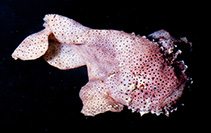| Family: |
Histiophrynidae (Starfingered frogfishes) |
| Max. size: |
4.81 cm SL (male/unsexed); 5.39 cm SL (female) |
| Environment: |
reef-associated; marine; depth range - 5 m |
| Distribution: |
Pacific Ocean: Indonesia and Philippines. Known only from shallow inshore waters of Lombok I. and Komodo I., Indonesia, and perhaps nearshore waters surrounding Cebu I., Philippines (Ref. 89955). |
| Diagnosis: |
Dorsal soft rays (total): 13-14; Anal soft rays: -7; Vertebrae: 20-20. This species is distinguished by having the entire body, including the lips and outer margins of the sclera, covered with small dark reddish to black spots encircled with a white ring; cheeks with numerous small shallow depressions, giving a pitted appearance to the head; an extremely small illicium and esca, barely discernible even with aid of a dissecting microscope; dark pink pigmentation overlaying a pale pink background, including a dark pink basidorsal spot; a small white encrusted patch of skin (resembling coralline algae) always present posterior to pectoral-fin origin, sometimes present on cheeks; head lightly covered with cutaneous cirri, especially around edges of opercle; upper and lower lips with short cutaneous cirri (Ref. 89955). |
| Biology: |
This species appears to occur within reef habitat and may be more active at night. Two procured specimens were observed to live peacefully together in an aquarium for many months (suggesting that Histiophryne may not be cannibalistic or as aggressive as Antennarius and Histrio) (Ref. 89955). |
| IUCN Red List Status: |
Not Evaluated (N.E.) Ref. (130435)
|
| Threat to humans: |
harmless |
Source and more info: www.fishbase.org. For personal, classroom, and other internal use only. Not for publication.
